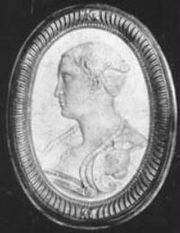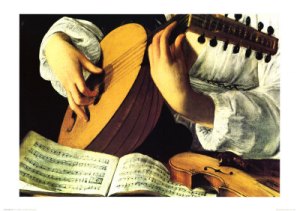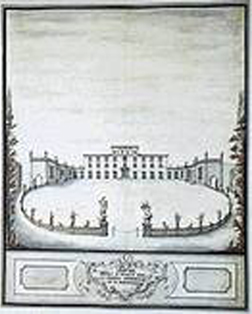
Francesca Caccini was born in mid-September 1587, the first-born child of two singers then on salary to produce chamber and theatre music for the Medici court–Lucia Gagnolandi, and Giulio Caccini (who was himself the second son of an ambitious wood dealer from Pisa). By 1587 Giulio was already one of the best-known singers and singing teachers of his generation, and the one professional singer known to have regularly participated in the conversations at courtier Giovanni de’Bardi’s Fiesole villa (known as La Camerata) that are supposed to have led to the two most stunning musical innovations of the 17th-century–the invention of a new kind of solo song, and the closely-related invention of new ways of setting plays to music that led directly to the emergence of opera as a genre.

Magnificat’s 2009-2010 season opened with a somewhat irreverent production of Francesca Caccini’s La Liberazione di Ruggiero on the weekend on October 16-18, 2009. The production marked the return of The Carter Family Marionettes, with their troupe of wooden trouble-makers, to Magnificat’s series.
Joshua Kosman of the San Francisco Chronicle expressed what many of the audience felt when he commented that “the Carters have wooden stand-ins not only for the main human characters but also for dragons and demons, birds and gamboling lambs, transformed trees and dancing sea horses, and the level of theatrical magic on display was enchanting.”

The following thoughtful review was posted at the blog Exotic and Irrational Entertainment by "Pessimissimo". I especially appreciate the recognition of the excellent program notes by Suzanne Cusick, who contributed tremendously to my understanding of Francesca and her "show". The reviewer's comments about Pulcinella are well taken, I would only point out that, the commedia figures were not only associated with Sicilian theatre, but with Italian theater in general and the performance of commedia troupes at any event like the visit of a foreign dignitary, especially during Carnival was taken for granted (and in fact mandatory for the companies enjoying the protection of the Medici). That being said, they certainly were not part of the original performance in 1625, but then neither were puppets of any sort. Thanks for such a well considered review!
This past week in the Bay Area the Baroque vocal group Magnificat (in collaboration with the Carter ...

Joshua Kosman of the San Francisco Chronicle attended last Saturday's sold out performance in Berkeley and has posted a review available online here.
We have posted more photos on our Flickr Photostream. Everyone perfromed beautifully and we had standing ovations for each performance. Thanks to everyone - performers, audience, staff and board - for making last weekend a tremendous success!

Cedric Westphal posted this preview of Magnificat's performance of La Liberazione di Ruggiero on SFist.com yesterday.
La Liberazione di Ruggiero is arguably the first opera written by a woman, and features strong feminist themes and a challenge to patriarchal society, but honestly, they had us at Puppet Opera. And not just any kind of puppets: three foot tall, forty pound puppets from Sicily, getting into sword fights and romance. It is actually quite common that your opera singers act stiff and wooden, and these puppets are no exception.
Written in 1625 by a woman, Francesca Caccini, for a woman, Maria Magdalena de Medici, who wanted to impress the visiting prince of Poland to her court of Tuscany, it is based on Ariosto's "Orlando Furioso". Magnificat Baroque will perform the score, under the baton of artistic director (and blogger) Warren Stewart, while the Carter Family Marionettes will do the visuals. We caught up ...

Lots more photos of the wooden cast of La Liberazione di Ruggiero can be viewed on our Flicker Photostream. Here's a few:

The Carter Family arrived and assembled their puppet stage for today's rehearsals of La Liberazione di Ruggiero. More photos can viewed at our Flicker page.

We've created a Flicker Photostream for this week's rehearsals of Caccini's La Liberazione di Ruggiero. Setting up the puppet stage now - photos soon!
Here are a few:

Introducing the cast - both human and wooden - for Magnificat's upcoming production of La Liberazione di Ruggiero. Presenting an opera with puppets allows the freedom for one singer to take on several roles. La Liberazione di Ruggiero features three primary roles: the galant, if temporarily mis-guided, knight Ruggiero and two sorceresses: the evil Alcina and and the benevolent Melissa. In addition there are shepherds, sirens, damigelle, and enchanted trees. (Full bios of all the musicians (and puppeteers!) in the production can be viewed here.)
Catherine Webster has been singing with Magnificat for ten years now. Since her unforgettable debut as a last minute addition in our first performance of the remarkable music of Chiara Margarita Cozzolani in 1999, Catherine has become an audience favorite. In this production she will sing the role of the evil sorceress Alcina, who has seduced Ruggiero, like so many knights before him, with her charm ...
“The 17th century was a big experiment,” Stewart said, referring to the arts as well as science. “Suddenly Earth was not the center of the universe but a tiny speck in space, and suddenly exaggerated human emotions were depicted in painting and in this new art form, opera.”
Lisa Hirsch of Iron Tongue of Midnight wrote the following preview of Magnificat's upcoming production of Francesca Caccini's La Liberazione di Ruggiero for San Francisco Classical Voice.
And that’s just what you can see next month when Magnificat Baroque, in collaboration with the Carter Family Marionettes, presents Francesca Caccini’s La liberazione di Ruggiero dall’Isola d’Alcina (The Liberation of Ruggiero from the island of Alcina) on Oct. 16, 17, and 18 in three venues.
In La liberazione, the wicked sorceress Alcina seduces the warrior Ruggiero, who dwells happily on Alcina’s island until finally the good sorceress Melissa shames him into returning to battle — and, incidentally, to his fiancée, the warrior maiden Bradamante. The plot comes from an episode in the epic Renaissance poem Orlando Furioso, by Ariosto, which is in turn based on the medieval French poem The Song of Roland.
That’s where the puppets come in.
The Carter Family Marionettes, who are ...

In the late Spring of 1608, a tragedy brought together the worlds of comedy and opera in Mantua for a magical performance.

Francesca Caccini’s La liberazione di Ruggiero fits into the Tuscan court’s long-term pattern of representing powerful women.

(This is the second of a three part essay on Francesca Caccini and La Liberzione di Ruggiero, which Magnificat will perform October 16-18. The first part, a biographical sketch of Francesca, "About Francesca", was posted here earlier.)
On February 3, 1625, sometime in daylight, 160 gentildonne and their husbands, and an unknown number of foreign guests rode in carriages out the southeastern gate of Florence, and half a mile up a tree-lined avenue to a villa atop the nearest hill that had very recently been renovated as the personal palace of Tuscany’s regent, Archduchess Maria Maddalena d’Austria. Leaving their carriages in a grassy courtyard guarded by two squadrons of armed cavalry, the Archduchess’ guests were welcomed into the palace by a military commander, and led to bench seats in a temporary theatre built in the villa’s loggia, to hear a new commedia in musica based on a well-known plot (two sorceresses ...

Recently while researching the Sicilian Opera dei Pupi tradition, I came across a pair of century old articles in the New York Times archives that tell a touching and compelling story of the impact of emerging technology on established artistic traditions. The first article, “Moving Pictures Oust the Puppets” from December 12, 1909 announces that the Marionette Theater of Antonio (Toni) Parisi has been “forced at last to give way to the march of time”. The subtitle tells the story: “Signor Parisi will follow progress by turning his place into a picture show."
From the article:
These are the last few lingering days of the Italian marionette theatre in Eleventh Street. Signor Toni Parisi is to shut up shop, stow away the heroes, Kings, knights, giants, Turks, the ladies in distress which have bobbed on his wires for more than twenty years and will run a moving-picture show instead. The reason is ...

“Marionettes have a long tradition of being able to bridge worlds and classes”
The Carter Family Marionettes are especially known for their mastery and preservation of the traditional Sicilian marionette theater known as Opera dei Pupi, which employs large-scale puppets manipulated with iron rods. This traditional form of puppetry flourished in the 19th century but the roots of the Opera dei Pupi stretch back to Middle Ages and earlier.
The original repertoire of Opera dei Pupi was based on the 11th-century Chanson de Roland, which recounted the legends of Emperor Charlemagne and his army of Christian knights and their battles with the invading Saracens. These legends passed through many literary re-elaborations during subsequent centuries, notably Ariosto's Orlando furioso and Tasso's Gerusalemme libera, served as the basis for Francesca Caccini’s La Liberazione di Ruggiero, which the Carters will be performing with Magnificat next month. In the 19th century, these tales of knights crossing ...

To say that La Liberazione di Ruggiero is a “setting” of Ludovico Ariosto’s Orlando furioso is not entirely accurate. Rather it is a “reworking”, a "re-telling", in which the librettist Ferdinando Saracinelli, a prominent figure and superintendent of performances for the Medici Court, was engaged in an ongoing tradition. The choices Saracinelli made in his libretto not surprisingly reflect the political agenda of his patroness, the Archduchess Maria Magdalena as well the concerns of the Florentine aristocracy in 1625.
In her survey of women at the Medici Court at the beginning of the 17th Century (Echoes of Women's Voices: Music, Art, and Female Patronage in Early Modern Florence, Chicago: University of Chicago Press, 2006), Kelly Harness points out that Saracinelli’s libretto draws as much from Tasso’s Gerusalemme liberata as from Ariosto. His effort was another installment in the multi-generational life of a good yarn. Grazio Braccioli, the librettist for Vivaldi’s Orlando ...

The Carter Family Marionettes, who will be coming to the Bay Area for Magnificat's production of Francesca Caccini's La Liberazione di Ruggiero in October, performed at the Festa Italiana in Portland, Oregon over the weekend. As Dmitri Carter noted on Facebook:
Just returned from performing at Festa Italiana in Portland. We had a brave crowd on Friday that sat in the rain! We rushed puppets away as soon as their scene was done. A friend lent an umbrella to put over the sound system to avoid electrocution. Luckily, it was dry for the other shows.
Fortunately the performances in October will be inside! Benjamin Brink of The Oregonian posted a gallery of backstage photographs that can be viewed here, but we wanted to share a couple with you.

To the extent that Francesca Caccini is known at all to music lovers today it is as the first woman to compose an opera. Imagine the disappointment of learning that the opera for which she is famous, La Liberzaione di Ruggiero, was in fact not an opera at all!
On a certain level, it’s just a matter of how you define your terms, and La Liberzaione di Ruggiero certainly meets the most generic definition in The New Grove: “a musical dramatic work in which the actors sing all or some of the parts”. That being said, the composer’s own designation and the circumstances and purposes of its composition support Suzanne Cusick‘s flat assertion that “La Liberazione is clearly not an opera”. She goes on to explain:
"It is, as its sources’ title pages attest a “balletto composto in musica” – an entirely sung, plotted entertainment meant to end in dancing that, in ...

Reba Wissner of Brandeis University has posted a thoughtful review of Suzanne Cusick's recently published book, Francesca Caccini at the Medici Court: Music and the Circulation of Power (University of Chicago Press, July 2009.) I encourage you to read the full review at Music Book Reviews, but I wanted to quote a couple paragraphs here.
Francesca Caccini was one of the most prolific female composers and performers of the seventeenth century, and recently, musicologists and interdisciplinarians have generated an extensive body of literature on the role of women in early modern Europe, mainly in Italy. Suzanne G. Cusick’s study of the composer eloquently situates itself within that realm. This, Cusick’s first book, has been long awaited. A scholar known for her enlightening and engaging articles on subjects such as feminist perspectives on early music and the use of music as torture in terrorist containment camps, it is high time for a ...

















